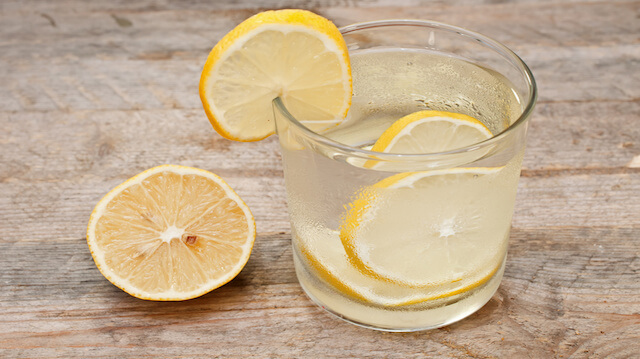19 Balancing Benefits of This Two-Ingredient Morning Tonic
Many of us have morning routines that are wonderful health practices — a morning meditation, a few yoga poses, a brisk walk around the neighborhood, or a delicious fruit-infused smoothie. Daily routines are vital to health and happiness, and this is especially true at the start of the day.
How about a quick and simple glass of warm lemon water with Himalayan salt? This simple drink can boost your morning health and wellness regimen — and it’s so easy to make. There are a number of professional athletes and Olympians who start their morning with lemon and salt water, which may say something about its effectiveness.
A 10-ounce glass of warm lemon water with Himalayan salt in the morning can increase your immune function, decrease uric acid to fight inflammation, improve digestion, and balance your body. These benefits can be attributed to the vitamin C content of the lemon juice as well as the essential minerals contained in Himalayan salt. This simple morning drink promotes vitality, health, and overall wellness, and may even improve your sex drive!
Let’s take a closer look at 19 of the balancing benefits of water, lemon, and salt, all in one cup.
Lemons are excellent for fighting inflammation. Lemons can help dissolve the uric acid in your joints, and also have been found to help build and repair tendons, ligaments, and bone. This anti-inflammatory property may be especially beneficial for people with rheumatoid arthritis and osteoarthritis, according to an American College of Physicians study on osteoarthritis, published in the Annals of Internal Medicine (2000).
Aids in proper food and water absorption. A daily glass of lemon water with Himalayan salt may provide a better overall mineral balance, which promotes proper food and water absorption in your body, allowing essential nutrients to get where they need to be.
Balances your body’s acidity (pH). The alkalizing effects of lemon and natural salt are highly useful for managing your body’s delicate pH balance, which is crucial for optimal functioning of the body’s systems.
Boosts immune function. One lemon serves up 139 percent of your daily value (DV) for vitamin C. Squeezing one lemon into your morning is a natural alternative to that vitamin C supplement you may be taking.
It’s a detox for your cells. The all-natural Himalayan salt mixed with lemon juice and water helps to pull toxins from your cells, reducing cellular toxicity. This may reduce your risk for various chronic diseases, as well as make you feel generally awesome!
Reduces problematic cellulite. Natural salts like Himalayan salt have been used for centuries for skin care. Interestingly, most spa treatments for cellulitis contain some form of salt and/or citrus blend. A few daily gulps of lemon and salt water in the morning may firm up a few of those unsightly areas.
Clears up skin and adds a fresh glow. Using natural salt for skin problems, such as psoriasis and eczema, dates back to ancient Roman times. Roman emperor Marcus Aurelius’ doctor, Galen from Pergamum, used sea salt for skin diseases, according to Science Tribune (1999).
 Useful for allergy season. It has been suggested that the combination of lemon and salt, specifically mixed into warm water, acts as a natural antihistamine for allergies. It may be the perfect alternative to those pink pills that leave you feeling drowsy.
Useful for allergy season. It has been suggested that the combination of lemon and salt, specifically mixed into warm water, acts as a natural antihistamine for allergies. It may be the perfect alternative to those pink pills that leave you feeling drowsy.
Paves the way for better sleep. The natural hormone-balancing properties of lemon and Himalayan salt can be more than useful when it comes to bedtime. Getting the proper amount of sleep is essential for physical health, mental health, productivity, and much more. This hormone-balancing beverage can make an effective nightcap.
Helps controls blood sugar. The fiber content of lemons helps to balance blood glucose levels, which is useful for type 2 diabetes patients and prediabetics alike, according to a study published in the New England Journal of Medicine (2000).
Lemons may help detoxify your liver. Vitamin C is essential for producing glutathione, which plays a foundational role in detoxifying the liver. It also has antiseptic properties that are useful for liver function, as well.
Freshens breath! Lemon and Himalayan salt may not be the first things that come to mind when you think of fresh breath. However, the lemon and salt in this simple morning drink help kill the bad breath bacteria that build up while you’re sleeping.
May help you chill out. When you get stressed out, do not be so quick to reach for those prescription pills. You may be able to chill out and return to that state of Zen by boosting your vitamin C levels first thing in the morning.
Useful for reducing blood pressure. Lemons are not all about vitamin C and fiber. They also boast potassium, which is vital for flushing excessive sodium from the body.
Boost your libido! The vitamin C content and hormone-balancing properties of this morning beverage can help lift your mood. This might be all it takes to boost your libido, without the need for that little blue pill.
Gets you hydrated right out of the gate. Many people forget how important hydration is, especially after a seven or eight-hour sleep period with no water. Start your morning off right and get hydrated. The water, salt and zesty lemon will get your day off to the perfect start.
An antioxidant powerhouse vital for, well, everything! Lemon offers up a wealth of vitamins and minerals, while Himalayan salt boosts your mineral and trace mineral levels even more. The antioxidant and detoxifying properties of lemon saltwater pack a powerful, free radical knockout punch.
May improve your heart health. Lemons and real salt are both exceptional for increasing heart health on their own. However, when you combine the two into one vibrant morning drink, you get even more vital heart-thumping health benefits.
Natural salt supports electrochemical reactions in the body, while negative ions assist in healthy heart rhythm. Lemons are rich in vitamin C, which is, “associated with lower endothelial dysfunction in men with no history of cardiovascular disease or diabetes,” according to a study published in the American Journal of Clinical Nutrition (2006).
Promotes digestive health. A glass of warm lemon water with Himalayan salt before breakfast, or any meal, helps signal your liver to produce the essential bile needed to clean out harmful gut bacteria. The fiber content and natural salt will also promote digestion.
Are you ready to commit to this simple and health-promoting morning drink? I have been drinking warm lemon water with Himalayan salt every morning for months, and I absolutely love it. My energy levels are up, and I feel as cool as a cucumber throughout the day.
19 Balancing Benefits of This Two-Ingredient Morning Tonic Read More »




















